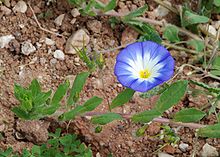- Convolvulus tricolor
-
Convolvulus tricolor 
Scientific classification Kingdom: Plantae Subkingdom: Tracheobionta Division: Magnoliophyta (unranked): Eudicots Class: Magnoliopsida Subclass: Asteridae Order: Solanales Family: Convolvulaceae Genus: Convolvulus Species: C. tricolor Binomial name Convolvulus tricolor
L.Convolvulus tricolor (syn. C. minor), is a species of morning glory known by the common name Dwarf Morning Glory.
Contents
Description
It is a short to medium annual plant with solitary long-stalked flowers. The flower is a tri-coloured funnel-shaped bloom about three centimeters wide, blue with white and a yellow centre. The leaves are oval to elliptic, untoothed and unstalked.
Taxonomy
Synonyms
- Convolvulus maroccanus Batt.
- Convolvulus meonanthus Hoffmanns. & Link
- Convolvulus minor
- Convolvulus pseudotricolor Bertol.
Subspecies
- Convolvulus tricolor subsp. hortensis (Batt.) Maire
- Convolvulus tricolor subsp. meonanthus (Hoffmanns. & Link) Maire
- Convolvulus tricolor subsp. pentapetaloide O. Bolòs & Vigo
- Convolvulus tricolor subsp. tricolor L.
O. Bolòs et J. Vigoe distinguish Convolvulus tricolor ssp pentapetaloides (L.), found in the Balearic isles, from the type subspecies (Convolvulus tricolor ssp tricolor) by flowers that are smaller (7-10 mm), and both the calyx and the capsule having few or no hairs. [2]Habitat
Common on cultivated land, dry open habitats, sandy places and roadsides.
Distribution
This flowering plant is native to the Mediterranean Basin, particularly the south, but it is occasionally seen in other areas of similar climate. In Spain it can be found in the Balearic Islands, [2] and Andalusia, especially in the Costa del Sol. [3]
Cultivation
C. tricolor is usually cultivated for ornamental purposes. Cultivars include: Red Ensign, Blue Ensign
References
- ^ [http://www.anthos.es/v22/index.php?set_locale=es Convolvulus tricolor Real Jardín Botánico: Proyecto Anthos
- ^ a b Herbario Virtual: Convolvulus tricolor L. subsp. pentapetaloides
- ^ García Guardia, G. (1988). Flores Silvestres de Andalucía. Alcorcón:Rueda. ISBN 84-7207-049-2.
Sources

This Solanales article is a stub. You can help Wikipedia by expanding it.
